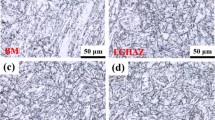Abstract
The objectives of this research are to study the influence of microstructure on the fatigue crack growth behavior in 4340 steel and to explore the application of the nanoindentation technique for determining the plastic deformation zone at a fatigue crack tip. Two heat treatment conditions were chosen for the steel: annealed and quenched plus tempered. The annealed steel consists of coarse pearlite and proeutectoid ferrite, while the quenched and tempered steel consists of fine tempered martensite. Fatigue crack propagation tests were conducted on disklike compact (DCT) specimens. Subsequently, the nanoindentation technique was applied to quantitatively determine the plastic deformation zone at fatigue crack tips. The plastic deformation zone size determined by the nanoindentation test seems larger than the cyclic deformation zone calculated using the fracture mechanics equation, which involves many assumptions. The fatigue crack growth test results show that the annealed steel has a higher resistance to crack growth than the quenched and tempered steel. The fatigue crack in the annealed steel tends to grow along pearlite domain boundaries, or the cementite/ferrite interfaces within a pearlite domain. In contrast, the fatigue crack in the quenched and tempered steel tends to traverse the fine martensite laths. Consequently, the actual crack path in the annealed steel is rougher than in the quenched and tempered steel and more secondary cracks are observed in the annealed steel.
Similar content being viewed by others
References
M.H. Swain, R.A. Everett, J.C. Newman, Jr., and E.P. Phillips: “The Growth of Short Cracks in 4340 Steel and Aluminum-Lithium 2090,” NASA Report N91-11247/4, NITS, Gaithersburg, MD, 1991.
P.S. Pao: ASM Handbook, vol. 19, Fatigue and Fracture, ASM, Materials Park, OH, 1996, pp. 185–92.
ASM Handbook, vol. 19, Fatigue and Fracture, ASM, Materials Park, OH, 1996, pp. 614–54.
R.W. Landgraf: ASM Handbook, vol. 19, Fatigue and Fracture, ASM, Materials Park, OH, 1996, pp. 603–13.
J.A. Bannantine, J.J. Comer, and J.L. Handrock: Fundamentals of Metal Fatigue Analysis, Prentice-Hall, Inc., Englewood Cliffs, NJ, 1990.
H. O’Neill: Hardness Measurement of Metals and Alloys, 2nd ed., Chapman and Hall Ltd., London, 1967.
ASTM Standard E647-95a, “Standard Test Method for Measurement of Fatigue Crack Growth Rates,” Annual Book of ASTM Standards, ASTM, Philadelphia, PA, vol. 03.01, 1996.
A. Saxena and C.L. Muhlstein: ASM Handbook, vol. 19, Fatigue and Fracture, ASM, Materials Park, OH, 1996, pp. 168–84.
ASM Handbook, vol. 19, Fatigue and Fracture, ASM, Materials Park, OH, 1996, pp. 964–79.
Author information
Authors and Affiliations
Rights and permissions
About this article
Cite this article
Yang, F., Saxena, A. & Riester, L. Use of the nanoindentation technique for studying microstructure/crack interactions in the fatigue of 4340 steel. Metall Mater Trans A 29, 3029–3036 (1998). https://doi.org/10.1007/s11661-998-0210-2
Received:
Issue Date:
DOI: https://doi.org/10.1007/s11661-998-0210-2




